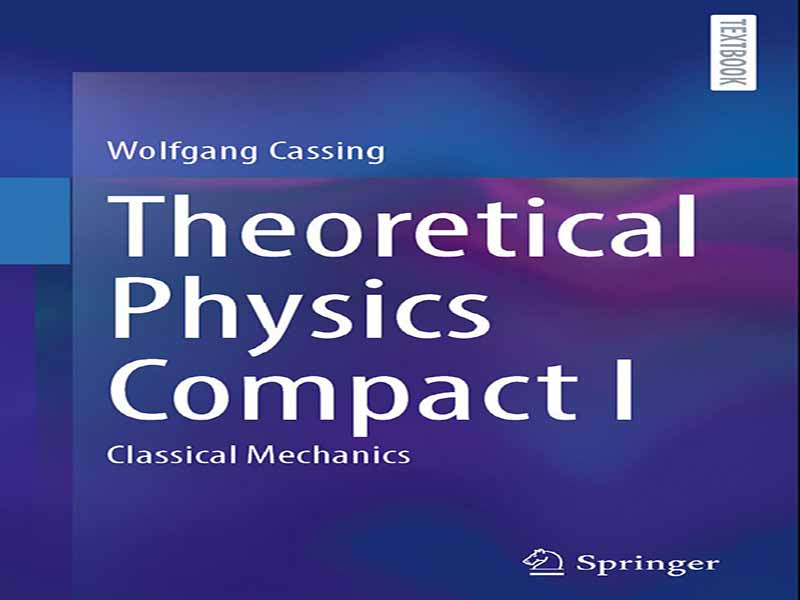- عنوان کتاب: Theoretical Physics Compact I -Classical Mechanics
- نویسنده: Wolfgang Cassing
- حوزه: فیزیک نظری
- سال انتشار: 2025
- تعداد صفحه: 203
- زبان اصلی: انگلیسی
- نوع فایل: pdf
- حجم فایل: 4.65 مگابایت
این کتاب، یک کتاب درسی در مورد مکانیک کلاسیک ارائه میدهد و به ویژه برای دانشجویان کارشناسی در سال اول تحصیل در رشته فیزیک نظری مناسب است. الزامات ریاضی شامل دانش مشتقگیری و انتگرالگیری است و اثباتهای ریاضی تا حد امکان ساده، اما در عین حال دقیق نگه داشته شدهاند. در صورت نیاز، عناصر جبر خطی در متن به تفصیل در زمینه تبدیلات مختصات، چرخشها، تبدیلات گالیله یا لورنتس توضیح داده شدهاند. پس از تعریف کمیتهای فیزیکی مورد توجه در سینماتیک نقاط جرم در سیستمهای لخت، تبدیلات بین سیستمهای لخت مختلف استخراج میشوند. پس از این فصلهای مقدماتی، دینامیک نیوتنی فرمولبندی شده و مثالهایی برای حل معادلات حرکت ارائه میشود. علاوه بر این، ارتباط تنگاتنگ بین ناوردایی گالیله و قوانین پایستگی تکانه و تکانه زاویهای اشاره شده است. در مورد نیروهای پایستار، میتوان انرژی پتانسیلی را فرمولبندی کرد که – همراه با انرژی جنبشی نقاط جرم – انرژی سیستم را میدهد. پایستگی کل انرژی برای یک سیستم بسته به روشی ساده دنبال میشود. کاربردهای مکانیک نیوتنی برای نیروهای ۱/r۲ منجر به قوانین کپلر برای حرکت سیارات میشود و میتوان یک میدان گرانشی برای توزیع جرم استاتیک تعریف کرد. کاربرد مهم دیگر، میرایی یا هدایت نوسانگر هماهنگ توسط یک نیروی تناوبی خارجی است. از آنجایی که معادلات ماکسول برای الکترودینامیک، ثابت گالیلهای نیستند، یک قانون تبدیل جدید (تبدیل لورنتس) استخراج میشود که سرعت نور c را در تمام سیستمهای لخت که با سرعت نسبی υ < c حرکت میکنند، ثابت نگه میدارد. برخی از پیامدها مانند انقباض لورنتس، اتساع زمان، همزمانی یا علیت رویدادها ذکر شدهاند. جنبههای ریاضی تبدیلات لورنتس ذکر شده و دینامیک نسبیتی برای نقاط جرم بر این اساس استخراج شده است. علاوه بر این، نشان داده شده است که معادلات نسبیتی حرکت برای سرعتهای کوچک υ ≪ c با دینامیک نیوتنی ادغام میشوند. ساختار رسمی مکانیک در بخش دوم این کتاب مورد بررسی قرار گرفته است که هدف آن فرمولبندی جبری دینامیک است که مستقل از انتخاب مختصات خاص یک ناظر است. پس از معرفی مختصات تعمیمیافته، که محدودیتهای سیستم ذرات را در نظر میگیرند و از معرفی نیروهای اجباری جلوگیری میکنند، تابع لاگرانژ و یک اصل تغییرات را برای استخراج معادلات حرکت لاگرانژ معرفی میکنیم. تبدیل لژاندر از تابع لاگرانژ به تابع همیلتون منجر به توصیف دینامیک در متغیرهای فضای فاز، یعنی مختصات و تکانههای تعمیمیافته، میشود. معادلات حرکت لاگرانژ به معادلات حرکت همیلتون تبدیل میشوند که میتوانند توسط براکتهای پواسون برای تحول زمانی یک مشاهدهپذیر بیان شوند. نشان داده شده است که معادلات همیلتون نسبت به تبدیلات نقطهای و تبدیلات کانونی توسعهیافته متغیرهای فضای فاز ثابت هستند، به طوری که یک فرمولبندی رسمی از مکانیک کلاسیک حاصل میشود که راه را برای فرمولبندی مکانیک کوانتومی، مکانیک پیوسته و مکانیک آماری هموار میکند. در پیوستها، توابع لاگرانژ و همیلتون نسبیتی برای مسائل مشخصه و همچنین الگوریتمهای عددی برای مشتقگیری و انتگرالگیری ارائه شده است. علاوه بر این، الگوریتمهایی از مراتب مختلف برای حل معادلات دیفرانسیل ارائه شده است.
This book provides a textbook on classical mechanics and is in particular suited for bachelor students in their irst year of studies in theoretical physics. The mathematical requirements include a knowledge of differentiation and integration and mathematical proofs are kept as simple as possible, however, still kept stringent. Elements of linear algebra are explained in detail in the text if needed in the context of coordinate transformations, rotations, Galilei or Lorentz transformations. After deining the physical quantities of interest in the kinematics of mass points in inertial systems, the transformations between different inertial systems are derived. After these preparatory chapters, the Newtonian dynamics is formulated and examples for the solution of the equations of motion are presented. Furthermore, the tight connection between Galilei invariance and the conservation laws of momentum and angular momentum are pointed out. In case of conservative forces a potential energy can be formulated that—together with the kinetic energy of mass points—gives the energy of the system. The conservation of the total energy for a closed system follows in a straight forward manner. Applications of Newtonian mechanics for 1/r2-forces lead to Kepler’s laws for the motion of planets and a gravitational ield for a static mass distribution can be deined. Another important application is the harmonic oscillator being damped or driven by an external periodic force. Since Maxwell’s equations for electrodynamics are not Galilei invariant a new transformation law is derived (Lorentz transformation), which keeps the velocity of light c invariant in all inertial systems moving with relative velocity υ < c. Some consequences are pointed out such as Lorentz contraction, time dilation, simultaneity, or causality of events. Mathematical aspects of Lorentz transformations are pointed out and the relativistic dynamics for mass points are derived accordingly. It is, furthermore, shown that the relativistic equations of motion merge with Newtonian dynamics for small velocities υ ≪ c. The formal structure of mechanics is addressed in the second part of this book that aims at an algebraic formulation of the dynamics, which is independent on the particular choice of coordinates of an observer. After introducing generalized coordinates, that account for constraints on the system of particles and avoid the introduction of coercive forces, we introduce the Lagrange function and a variational principle to derive the Lagrange equations of motion. A Legendre transformation of the Lagrange function to the Hamilton function will lead to a description of the dynamics in phase-space variables, i.e. generalized coordinates and momenta. The Lagrange equations of motion turn to Hamilton’s equations of motion, which can be expressed by Poisson brackets for the time evolution of an observable. The latter are shown to be invariant with respect to point transformations and extended canonical transformations of the phase-space variables such that a formal formulation of the classical mechanics is achieved that paves the way for the formulation of quantum mechanics, continuum mechanics, and statistical mechanics. In the appendices the relativistic Lagrange and Hamilton functions for characteristic problems are given as well as numerical algorithms for differentiation and integration. Furthermore, algorithms of different order for the solution of differential equations are presented.
این کتاب را میتوانید از لینک زیر بصورت رایگان دانلود کنید:
Download: Theoretical Physics Compact I -Classical Mechanics



































نظرات کاربران